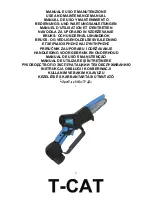
Page 8
For technical questions, please call 1-800-444-3353.
SKU 94245
To reduce vibration, maintain the tool
7.
as explained in this manual. If any
abnormal vibration occurs, stop use
immediately.
SAVe tHeSe
INStRUCtIONS.
gROUNdINg
tO pReVeNt
eLeCtRIC SHOCK
ANd deAtH FROM INCORReCt
gROUNdINg WIRe
CONNeCtION:
Check with a qualified electrician
if you are in doubt as to whether
the outlet is properly grounded.
do not modify the power cord
plug provided with the tool.
Never remove the grounding
prong from the plug. do not use
the tool if the power cord or plug
is damaged. If damaged, have it
repaired by a service facility
before use. If the plug will not fit
the outlet, have a proper outlet
installed by a qualified
electrician.
double Insulated tools: tools with
two prong plugs
Outlets for 2-prong plug
Tools marked “Double Insulated” do not
1.
require grounding. They have a special
double insulation system which satisfies
OSHA requirements and complies with
the applicable standards of Underwriters
Laboratories, Inc., the Canadian
Standard Association, and the National
Electrical Code.
Double insulated tools may be used in
2.
either of the 120 volt outlets shown in the
preceding illustration.
(See Outlets for
2-prong plug.)
extension Cords
Grounded
1.
tools require a three wire
extension cord.
Double Insulated
tools can use either a two or three wire
extension cord.
As the distance from the supply outlet
2.
increases, you must use a heavier gauge
extension cord. Using extension cords
with inadequately sized wire causes a
serious drop in voltage, resulting in loss
of power and possible tool damage.
(See table A.)
The smaller the gauge number of the
3.
wire, the greater the capacity of the cord.
For example, a 14 gauge cord can carry
a higher current than a 16 gauge cord.
(See table A.)
When using more than one extension
4.
cord to make up the total length, make
sure each cord contains at least the
minimum wire size required.
(See table
A.)
If you are using one extension cord for
5.
more than one tool, add the nameplate
amperes and use the sum to determine
the required minimum cord size.
(See
table A.)
If you are using an extension cord
6.
outdoors, make sure it is marked with the
suffix “W-A” (“W” in Canada) to indicate it
is acceptable for outdoor use.




































